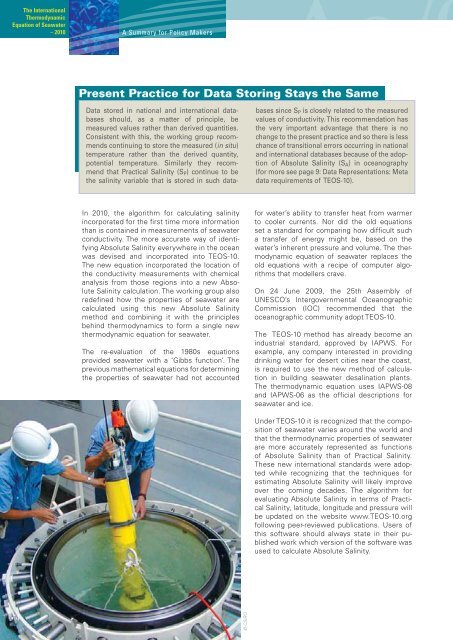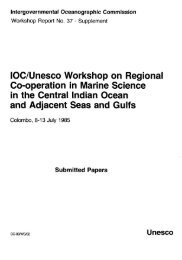The International thermodynamic equation of ... - unesdoc - Unesco
The International thermodynamic equation of ... - unesdoc - Unesco
The International thermodynamic equation of ... - unesdoc - Unesco
- No tags were found...
You also want an ePaper? Increase the reach of your titles
YUMPU automatically turns print PDFs into web optimized ePapers that Google loves.
ΣΑ = Δρ/0Σ– A Summary for Policy Makers2010ΣΑ<strong>The</strong> <strong>International</strong><strong>The</strong>rmodynamicEquation <strong>of</strong> SeawaterPresent Practice for Data Storing Stays the SameData stored in national and international databasesshould, as a matter <strong>of</strong> principle, bemeasured values rather than derived quantities.Consistent with this, the working group recommendscontinuing to store the measured (in situ)temperature rather than the derived quantity,potential temperature. Similarly they recommendthat Practical Salinity (S P ) continue to bethe salinity variable that is stored in such databasessince S P is closely related to the measuredvalues <strong>of</strong> conductivity. This recommendation hasthe very important advantage that there is nochange to the present practice and so there is lesschance <strong>of</strong> transitional errors occurring in nationaland international databases because <strong>of</strong> the adoption<strong>of</strong> Absolute Salinity (S A ) in oceanography(for more see page 9: Data Representations: Metadata requirements <strong>of</strong> TEOS-10).In 2010, the algorithm for calculating salinityincorporated for the first time more informationthan is contained in measurements <strong>of</strong> seawaterconductivity. <strong>The</strong> more accurate way <strong>of</strong> identifyingAbsolute Salinity everywhere in the oceanwas devised and incorporated into TEOS-10.<strong>The</strong> new <strong>equation</strong> incorporated the location <strong>of</strong>the conductivity measurements with chemicalanalysis from those regions into a new AbsoluteSalinity calculation. <strong>The</strong> working group alsoredefined how the properties <strong>of</strong> seawater arecalculated using this new Absolute Salinitymethod and combining it with the principlesbehind <strong>thermodynamic</strong>s to form a single new<strong>thermodynamic</strong> <strong>equation</strong> for seawater.<strong>The</strong> re-evaluation <strong>of</strong> the 1980s <strong>equation</strong>sprovided seawater with a ‘Gibbs function’. <strong>The</strong>previous mathematical <strong>equation</strong>s for determiningthe properties <strong>of</strong> seawater had not accountedfor water’s ability to transfer heat from warmerto cooler currents. Nor did the old <strong>equation</strong>sset a standard for comparing how difficult sucha transfer <strong>of</strong> energy might be, based on thewater’s inherent pressure and volume. <strong>The</strong> <strong>thermodynamic</strong><strong>equation</strong> <strong>of</strong> seawater replaces theold <strong>equation</strong>s with a recipe <strong>of</strong> computer algorithmsthat modellers crave.On 24 June 2009, the 25th Assembly <strong>of</strong>UNESCO’s Intergovernmental OceanographicCommission (IOC) recommended that theoceanographic community adopt TEOS-10.<strong>The</strong> TEOS-10 method has already become anindustrial standard, approved by IAPWS. Forexample, any company interested in providingdrinking water for desert cities near the coast,is required to use the new method <strong>of</strong> calculationin building seawater desalination plants.<strong>The</strong> <strong>thermodynamic</strong> <strong>equation</strong> uses IAPWS-08and IAPWS-06 as the <strong>of</strong>ficial descriptions forseawater and ice.Under TEOS-10 it is recognized that the composition<strong>of</strong> seawater varies around the world andthat the <strong>thermodynamic</strong> properties <strong>of</strong> seawaterare more accurately represented as functions<strong>of</strong> Absolute Salinity than <strong>of</strong> Practical Salinity.<strong>The</strong>se new international standards were adoptedwhile recognizing that the techniques forestimating Absolute Salinity will likely improveover the coming decades. <strong>The</strong> algorithm forevaluating Absolute Salinity in terms <strong>of</strong> PracticalSalinity, latitude, longitude and pressure willbe updated on the website www.TEOS-10.orgfollowing peer-reviewed publications. Users <strong>of</strong>this s<strong>of</strong>tware should always state in their publishedwork which version <strong>of</strong> the s<strong>of</strong>tware wasused to calculate Absolute Salinity.4© CSIRO
















